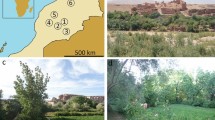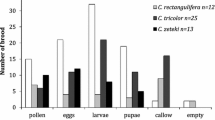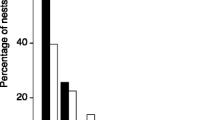Abstract
The bee tribe Ceratinini provides important insights into the early stages of sociality. Many arthropods exhibit behaviours precursory to social life, including adult longevity, parental care, nest loyalty and mutual tolerance, yet the origins of social behaviour are few. Here we describe the biology of a facultatively social bee, Ceratina (Neoceratina) australensis, which exhibits all of the preadaptations for successful group living, yet presents ecological and behavioural characteristics that seemingly disfavour frequent colony formation. This species is socially polymorphic with both solitary and social nests collected in sympatry. Social colonies consist of two foundresses, one contributing both foraging and reproductive effort and the second which remains at the nest as a passive guard. Cooperative nesting provides no overt reproductive benefits over solitary nesting in this population, although brood survival tends to be greater in social colonies. Maternal longevity, subsociality and bivoltine nesting phenology in this species favour colony formation, while dispersal habits and offspring longevity may inhibit more frequent social nesting in this and other ceratinines.




Similar content being viewed by others
References
Batra S.W.T. 1966. The life cycle and behavior of the primitively social bee, Lasioglossum zephyrum. Univ. Kansas Sci. Bull. 46: 359-423
Cartar R. 1992. Morphological senescence and longevity: an experiment relating wing wear and life span in foraging wild bumble bees. J. Anim. Ecol. 61: 225-231
Chenoweth L.B., Tierney S.M., Smith J.A., Cooper S.J.B. and Schwarz M.P. 2007. Social complexity in bees is not sufficient to explain lack of reversions to solitary living over long time scales. BMC Evol. Biol. 7: 246
Daly H.V. 1966. Biological studies on Ceratina dallatoreana, an alien bee in California which reproduces by parthenogenesis (Hymenoptera: Apoidea). Ann. Entomol. Soc. Am. 59: 1138-1154
Daly H.V. 1988. Bees of the new genus Ctenoceratina in Africa south of the Sahara (Hymenoptera: Apoidea). University of California Press, Los Angeles. 69 pp
Danforth B.N. 2002. Evolution of sociality in a primitively eusocial lineage of bees. Proc. Natl Acad. Sci. U.S.A. 99: 286-290
Engel M.S. and Grimaldi D.A. 2005. Primitive new ants in Cretaceous amber from Myanmar, New Jersey, and Canada (Hymenoptera: Formicidae). Am. Mus. Novit. 3485: 1-23
Hogendoorn K. and Velthuis H.H.W. 1993. The sociality of Xylocopa pubescens: does a helper really help? Behav. Ecol. Sociobiol. 32: 247-257
Hogendoorn K. and Velthuis H.H.W. 1995. The role of young guards in Xylocopa pubescens. Insect. Soc. 42: 427-448
Hogendoorn K. and Velthuis H.H.W. 1999. Task allocation and reproductive skew in social mass provisioning carpenter bees in relation to age and size. Insect. Soc. 46: 198-207
Jeanson R., Kukuk P.F. and Fewell J.H. 2005. Emergence of division of labour in halictine bees: contributions of social interactions and behavioural variance. Anim. Behav. 70: 1183-1193
Johnson M.D. 1988. The relationship of provision weight to adult weight and sex ratio in the solitary bee, Ceratina calcarata. Ecol. Entomol. 13: 165-170
Katayama E. and Maeta Y. 1979. Brood development and adult activities of a small carpenter bee, Ceratina megastigmata (Hymenoptera: Anthophoridae). Kontyu 47: 139-157
Kidokoro M., Kikuchi T. and Hirata M. 2003. Prehibernal insemination and short dispersal of Ceratina flavipes (Hymenoptera: Anthophidae) in northernmost Japan. Ecol. Res. 18: 99-102
Kidokoro M., Noriko A. and Higashi S. 2006. Pre-hibernation mating by a solitary bee, Ceratina flavipes (Hymenoptera: Apidae: Xylocopinae). J. Nat. Hist. 40: 2101-2110
Kislow C.J. 1976. The comparative biology of two species of small carpenter bees, Ceratina strenua F. Smith and C. calcarata Robertson. PhD dissertation, University of Georgia, Athens, Georgia. 221 pp
Lin N. and Michener C.D. 1972. Evolution of sociality in insects. Q. Rev. Biol. 47: 131-159
Malyshev S.I. 1913. Life instincts of some Ceratina-bees (Hymenoptera: Apidae), a comparative and experimental study. Hor. Soc. Entomol. Ros. 40: 1-58
Maynard Smith J. and Szathamáry E. 1995. The Major Transitions in Evolution. Oxford University Press, New York. 346 pp
McCorquodale D.B. 1989. Nest defense in single- and multifemale nests of Cerceris antipodes (Hymenoptera: Sphecidae). J. Insect Behav. 2: 267-276
Michener C.D. 1962. The genus Ceratina in Australia with notes on its nests (Hymenoptera: Apoidea). J. Kans. Entomol. Soc. 35: 414-421
Michener C.D. 1969. Comparative social behaviour of the bees. Annu. Rev. Entomol. 14: 299-342
Michener C.D. 1974. The Social Behavior of the Bees. Harvard University Press, Cambridge. 404 pp
Michener C.D. 1985. From solitary to eusocial: need there be a series of intervening species? Fort. Zool. 31: 293-305
Michener C.D. 1990. Castes in xylocopine bees. In: Social Insects: An Evolutionary Approach to Castes and Reproduction (W. Engels, Ed), Springer Verlag, Berlin, New York. pp 123-146
Michener C.D. 2007. The Bees of the World, 2nd ed. The John Hopkins University Press, Baltimore. 953 pp
Packer L. 1986. The social organization of Halictus ligatus (Hymenoptera: Halictidae) in Southern Ontario. Can. J. Zool. 64: 2317-2324
Rau P. 1928. The nesting habits of the little carpenter-bee, Ceratina calcarata. Ann. Entomol. Soc. Am. 21: 380-396
Rehan S.M., Richards M.H. and Schwarz M.P. 2009. Evidence of social nesting in the Ceratina of Borneo. J. Kans. Entomol. Soc. 82: 194-209
Rehan S.M. and Richards M.H. 2010. Nesting biology and subsociality of Ceratina calcarata (Hymenoptera: Apidae). Can. Entomol. 142: 65-74
Sakagami S.F. and Maeta Y. 1977. Some presumably presocial habits of Japanese Ceratina bees, with notes on various social types in Hymenoptera. Insect. Soc. 24: 319-343
Sakagami S.F. and Maeta Y. 1984. Multifemale nests and rudimentary castes in the normally solitary bee Ceratina japonica (Hymenoptera: Xylocopinae). J. Kans. Entomol. Soc. 57: 639-656
Sakagami S.F. and Maeta Y. 1987. Multifemale nests and rudimentary castes of an ‘almost’solitary bee Ceratina flavipes, with additional observations on multifemale nests of Ceratina japonica (Hymenoptera, Apoidea). Kontyu 55: 391-409
Sakagami S.F. and Maeta Y. 1989. Compatibility and incompatibility of solitary life with eusociality in two normally solitary bees Ceratina japonica and Ceratina okinawana (Hymenoptera, Apoidea), with notes on the incipient phase of eusociality. Jap. J. Entomol. 57: 417-739
Sakagami S.F. and Maeta Y. 1995. Task allocation in artificially induced colonies of a basically solitary bee Ceratina (Ceratinidia) okinawana, with a comparison of sociality between Ceratina and Xylocopa (Hymenoptera, Anthophoridae, Xylocopinae). Jap. J. Ecol. 63: 115-150
Schwarz M.P. and O’Keefe K.J. 1991. Order of eclosion and reproductive differentiation in a social allodapine bee. Ethol. Ecol. Evol. 3: 233-245
Schwarz M.P., Richards M.H. and Danforth B.N. 2007. Changing paradigms in insect social evolution: insights from halictine and allodapine bees. Ann. Rev. Entomol. 52: 127-150
Smith A.R., Wcislo W.T. and O’Donnell S. 2003. Assured fitness returns favour sociality in a mass-provisioning sweat bee, Megalopta genalis (Hymenoptera: Halictidae) Behav. Ecol. Soc. 54: 14-21
Smith A.R., Wcislo W.T. and O’Donnell S. 2007. Survival and productivity benefits to social nesting in the sweat bee Megalopta genalis (Hymenoptera: Halictidae). Behav. Ecol. Sociobiol. 61: 1111-1120
Sokal R. and Rohlf F. 1995. Biometry, 3rd ed. Freeman, New York. 887 pp
Steen Z. 2000. Social behaviour in endemic Australian carpenter bees. PhD. dissertation, Flinders University, Adelaide, Australia. 211 pp
Tallamy D.W. and Wood T.K. 1986. Convergence patterns in subsocial insects. Annu. Rev. Entomol. 31: 369-390
Thorne B.L., Grimaldi D.A. and Krishna K. 2000. Early fossil history of the termites. In: Termites: Evolution, Sociality, Symbioses, Ecology (T. Abe, D.E. Bignell and Higashi S., Eds), Kluwer Academic Publishing, Dordrecht. pp 77-93
Tierney S.M. and Schwarz M.P. 2009. Reproductive hierarchies in the African allodapine bee Allodapula dichroa (Apidae; Xylocopinae) and ancestral forms of sociality. Biol. J. Linn. Soc. 97: 520-530
Wenzel J.W. 1990. A social wasp’s nest from the Cretaceous period, Utah, USA, and its biogeographical significance. Psyche 97: 21-29
Wcislo W.T. 1997. Social interactions and behavioral context in a largely solitary bee, Lasioglossum (Dialictus) figueresi (Hymenoptera, Halictidae). Insect. Soc. 44: 199-208
Wilson E.O. 1971. The Insect Societies. Harvard University Press, Cambridge. 562 pp
Zammit J., Hogendoorn K. and Schwarz M.P. 2008. Strong constraints to independent nesting in a facultatively social bee: quantifying the effects of enemies-at-the-nest. Insect. Soc. 55: 74-78
Acknowledgments
We wish to thank Sally Harradine for help in the field, Andrew Morse for the colony cycle drawing and the two anonymous reviewers for their helpful suggestions. This research was supported by an ARC grant to M.P.S., an NSERC grant to M.H.R. and Endeavour and NSERC scholarships to S.M.R.
Author information
Authors and Affiliations
Corresponding author
Rights and permissions
About this article
Cite this article
Rehan, S.M., Richards, M.H. & Schwarz, M.P. Social polymorphism in the Australian small carpenter bee, Ceratina (Neoceratina) australensis . Insect. Soc. 57, 403–412 (2010). https://doi.org/10.1007/s00040-010-0097-y
Received:
Revised:
Accepted:
Published:
Issue Date:
DOI: https://doi.org/10.1007/s00040-010-0097-y




